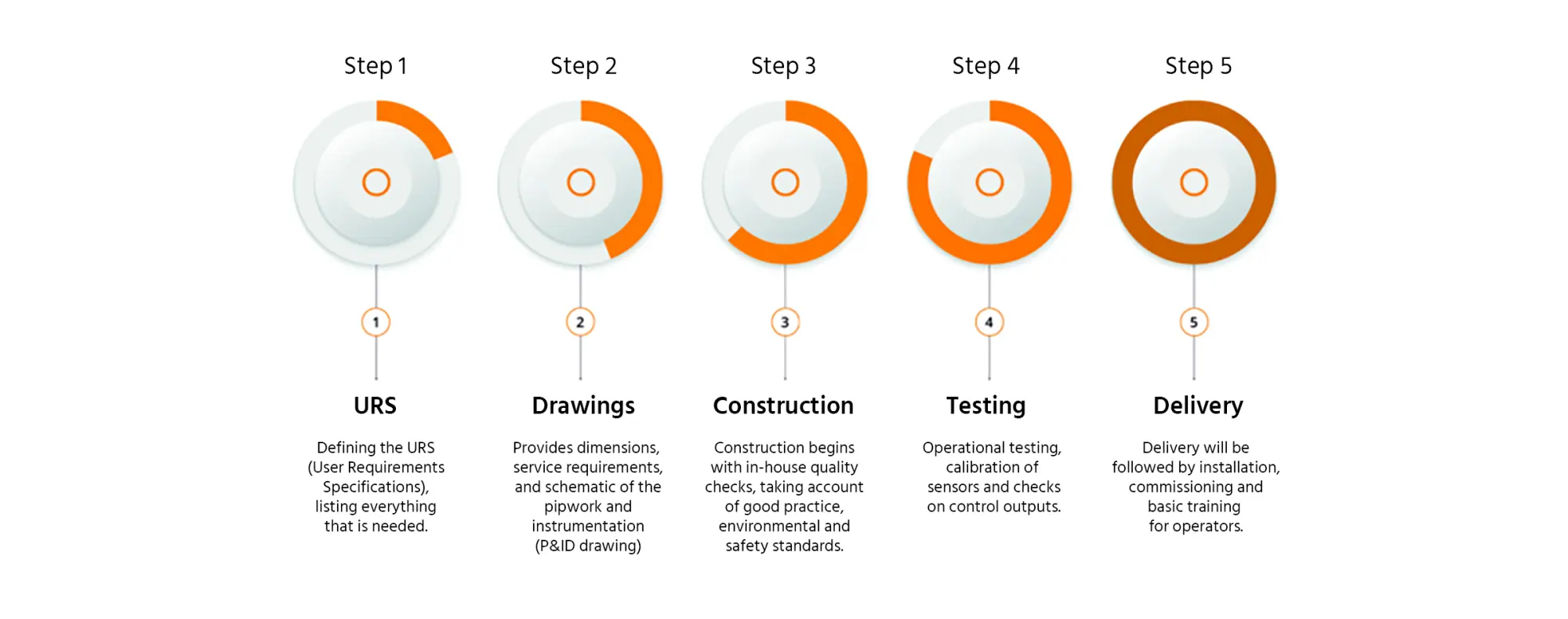1. Does it fit your requirements and workspace?
What working volume do you need for each batch and, having decided this, where can a unit of the right size be installed? Practicality this is simple, and it means you must have accurate dimensional drawings early in the process. Once there, can the necessary services be installed beforehand such as:
- Cooling water
- A low drain with heat-resistant pipework, that must also meet local municipal standards
- Electrical supply (both single and three phases are often needed)
- Oil-free, dry air and other gasses as needed (piped or bottled)
- Clean, dry steam (a steam generator may be integrated on units below 50L total volume)
- Process water (for filling and rinsing of larger vessels)
Don’t forget to check that room has been allocated for peripheral equipment e.g. pumps, centrifuges or analyzers to be used with the bioreactor. The space availability is only half the story – it must get to that place. A walk through of the route from your loading bay will highlight any doors, sharp turns, lifts and further obstacles.
2. How is your order processed?
A User Requirement Specification (URS) should be prepared, listing everything needed. This is created after discussions with other stakeholders, site engineers and network specialists. The URS often makes the key element of an invitation to tender, which will be generated and managed by your Purchasing Department.
The URS will be analyzed by specialists in different departments, to ensure each item is considered and a suitable response given in reply or as part of a formal quote. The responsibilities are divided as follows:
- Technical Support Construction (responsible for mechanical clarification and sequences)
- Technical Support Automation (responsible for the clarification of parameters, I/O list and electrical requirements)
- Quality Department (responsible for the required standards and quality documentation)
- Software (responsible for the requirements of control, recording, monitoring)
The reply to the URS will normally be a point–by–point confirmation. Any differences will be indicated, and alternatives suggested. At this stage, there may be questions and suggestions to consider. This will involve contact with the designers and other specialists to clarify these points.
Check the quotations carefully and make sure you compare “apples with apples”. Just because something can be fitted does not mean it will be fitted unless it is asked for. Furthermore, do not forget the peripheral items if you are setting up in a new location. Small items like reagent bottles will need sizing to the scale of the vessel and special fittings for transfer lines should be ordered in the right quantities. Even medium volume should be considered, especially if it is bought in ready for use.
Project milestones when buying an in-situ sterilizable bioreactor

3. Can the bioreactor be expanded over time?
A unit which has used up all its capacity for sensors and actuators at the outset may be difficult and expensive to upgrade. Therefore, a good indicator is if the controller has spare capacity to add analog signals or use a digital protocol such as Modbus. The vessel should be specified with spare ports (head plate and side ports) to allow for extra sensors if future expansion is likely, as these can be difficult to add later. Any costs associated with adding sensors to the local controller should be investigated when discussing specifications with suppliers.
4. How automated are the sterilization, cleaning and operating processes?
Automation of these processes is a critical factor and should especially be considered if trained operators are in short supply. These procedures should also be flagged and confirmed at the local Human Machine Interface (HMI) on the controller. Prepared phases and recipes are vital, with changes to standard options being recorded and stored between cycles. Steps initiated by the operator, such as seal testing and sample valve sterilization, should be timed and need no further action.
Furthermore, for cleaning in place procedures, the centrifugal pump and extra pipework needed can be mounted on the same frame as the bioreactor. This makes it compact, and as mobile as the bioreactor. Spray balls are fitted inside the bioreactor, through the top plate or side wall. It is usual to have two of these to ensure there are no “shadows” i.e. areas not cleaned by a single spray ball.
Lastly, safe operation for both operators and product are paramount. How the system behaves when, for example, steam pressure is lost should be examined. For operational steps, the ability to empty and fill reagent lines automatically can save time and effort. Local cascades and software-controlled workflows provided in the bioprocess software can reduce the need for operator interventions.
5. How easy is liquid-handling?
The traditional way of doing this is to use silicone septa in ports on the top plate and pierce them aseptically using a large needle. This still may be useful for some actions, such as addition of inoculum or small volumes of supplement. There are two further options to consider:
- A push valve removing the need for piercing a septum is good for reagents which can be autoclaved before use, along with the push valve. Multi port variants are also available.
- For feeds and liquids which must be used quickly, a sterile steam cross assembly can be used to connect a transfer line, sterilize the connection and then add the material.
- The key difference is that push valves are true extras and can be added to existing top plate ports as needed. A sterile cross is usually hard-piped, and of course, requires steam.